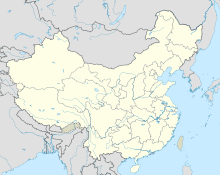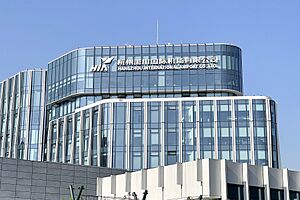Hangzhou Xiaoshan International Airport facts for kids
Quick facts for kids
Hangzhou Xiaoshan International Airport
杭州萧山国际机场
|
|||||||||||||||
|---|---|---|---|---|---|---|---|---|---|---|---|---|---|---|---|
 |
|||||||||||||||
 |
|||||||||||||||
| Summary | |||||||||||||||
| Airport type | Public | ||||||||||||||
| Operator | Hangzhou Xiaoshan International Airport Co. Ltd. | ||||||||||||||
| Serves | Hangzhou | ||||||||||||||
| Location | Yingbin Avenue, Xiaoshan District, Hangzhou, Zhejiang, China | ||||||||||||||
| Opened | 30 December 2000 | ||||||||||||||
| Hub for |
|
||||||||||||||
| Focus city for |
|
||||||||||||||
| Elevation AMSL | 7 m / 23 ft | ||||||||||||||
| Coordinates | 30°14′13.6″N 120°25′55.0″E / 30.237111°N 120.431944°E | ||||||||||||||
| Maps | |||||||||||||||
CAAC airport chart |
|||||||||||||||
| Runway | |||||||||||||||
|
|||||||||||||||
| Statistics (2021) | |||||||||||||||
|
|||||||||||||||
|
Source: [1]
|
|||||||||||||||
| Hangzhou Xiaoshan International Airport | |||||||
|---|---|---|---|---|---|---|---|
| Simplified Chinese | 杭州萧山国际机场 | ||||||
| Traditional Chinese | 杭州蕭山國際機場 | ||||||
|
|||||||
Hangzhou Xiaoshan International Airport is a very important airport. It serves Hangzhou, a big city in China. The airport is located near the Qiantang River in Xiaoshan District. It is about 27 kilometers (17 miles) east of downtown Hangzhou. A famous company called Aedas designed this airport.
This airport connects Hangzhou to many places. You can fly to cities all over China. There are also flights to countries in Asia, Europe, and Africa. Many airlines use this airport as a main base. These include Air China, China Eastern Airlines, and Hainan Airlines.
In 2017, over 35 million passengers used Hangzhou airport. This made it the tenth busiest airport in China for passengers. It was also very busy for cargo, handling over 589,000 tonnes of goods.
The airport has four main buildings for travelers, called terminals. These are Terminal 1, 2, 3, and 4. Terminal 2 handles all international flights. Terminals 1 and 3 are for flights within China. The newest building, Terminal 4, handles both international and some domestic flights. You can easily get to the airport from downtown Hangzhou by bus or metro. There is also a special elevated highway for cars.
Contents
History of the Airport
The airport was built in different stages. The first part started in July 1997. It opened on December 30, 2000. This new airport replaced an older one called Hangzhou Jianqiao Airport. The old airport was used by both regular planes and military planes.
In March 2004, the airport became an official international airport. This happened after new customs and immigration areas were built. A second runway was also built. Other parts of the airport were expanded in 2012.
KLM started the first flight from Hangzhou to another continent. This flight went to Amsterdam on May 8, 2010.
On July 9, 2010, the airport had to close for a short time. This was because something unusual was seen in the sky. Flights had to go to other nearby airports. This event caused a lot of talk in the news.
Airport Buildings and Features
The first part of the airport covers a large area. It was designed to handle 8 million passengers each year. It can also handle 110,000 tons of cargo. Very large planes, like the Boeing 747-400, can use this airport.
The airport has one runway that is 3,600 meters (11,800 feet) long. It is 45 meters (148 feet) wide. The main building for passengers is 100,000 square meters (1,076,000 square feet) in size. It has many counters for checking in. There are also many seats for people waiting for their flights.
The airport has special areas for planes to park. There are also 12 jetways. These are the bridges that connect the terminal to the plane.
The airport also has facilities to fix and maintain planes. They can do important checks on many types of aircraft.
The second phase of the airport expansion started in 2007. This added an international terminal and a second domestic terminal. A new runway was also built. The international terminal opened in 2010. It has gates that can handle very large planes like the Airbus A380. All international flights use this terminal. The other buildings handle flights within China. All these new parts were ready by 2012.
The third phase of the airport project finished in March 2022. This was a big step for the 19th Asian Games in Hangzhou. With this phase done, Hangzhou Airport became the second largest airport hub in East China.
The new Terminal 4 opened in September 2022. It is huge, covering 720,000 square meters (7,750,000 square feet). It can handle 50 million passengers every year. The design of Terminal 4 is inspired by lotus flowers. These flowers are a famous symbol of West Lake in Hangzhou. The building has special skylights that look like lotus flowers.
The newest runway is 3,400 meters (11,150 feet) long. It is 60 meters (200 feet) wide. This runway can also handle the Airbus A380. The new domestic Terminal 3 has many check-in desks. It also has 26 security lanes and 31 gates with jet bridges. All public areas in the terminal have free Wi-Fi. With these new additions, the airport can handle many more passengers.
Loong Airlines has its main office building right at the airport.
How to Get To and From the Airport
Airport Bus Services
There are many bus services from the airport. These buses connect to different places in Zhejiang and Jiangsu provinces. Buses to downtown Hangzhou stop at the Ticketing Office on Tiyuchang Road.
Train and Metro Connections
The Xiaoshan International Airport station is part of the Hangzhou Metro system. Passengers can use Line 1, Line 7, and Line 19. These lines connect the airport directly to the city center.
Highway Access
The airport is easy to reach by car. Airport Road connects to the Airport Expressway. This expressway links the airport to downtown Hangzhou using the Xixing Bridge. There is also an exit for Xiaoshan. The G92 Hangzhou Bay Ring Expressway also has an exit at the airport.
Flights and Destinations
Hangzhou Xiaoshan International Airport is a busy place! It has flights to many cities.
Passenger Flights
Many airlines fly passengers to and from Hangzhou. You can find flights to major cities in China. There are also international flights to places like:
- Air China flies to Bangkok–Suvarnabhumi, Dubai–International, Rome–Fiumicino, Seoul–Incheon, Tokyo–Narita.
- Beijing Capital Airlines flies to Lisbon, Madrid, Melbourne, Moscow–Sheremetyevo.
- China Eastern Airlines flies to Auckland, Ho Chi Minh City, Kuala Lumpur–International, Singapore, Sydney.
- Loong Air flies to Bangkok–Suvarnabhumi, Hong Kong, Jeju, Kuala Lumpur–International, Osaka–Kansai.
- Qatar Airways flies to Doha.
- Scoot flies to Singapore.
- XiamenAir flies to Hong Kong, Macau, Nagoya–Centrair, Osaka–Kansai, Singapore, Taipei–Taoyuan.
Cargo Flights
The airport also handles a lot of cargo. Special cargo airlines fly goods to different parts of the world:
- Air China Cargo flies to Liege and Madrid.
- Atlas Air flies to Anchorage and Chicago–O’Hare.
- SF Airlines flies to Los Angeles, New York–JFK, and Singapore.
- YTO Cargo Airlines flies to Dhaka, Dubai–Al Maktoum, Kuala Lumpur–International, Manila, Moscow–Sheremetyevo, Seoul–Incheon, Singapore, and Tashkent.
Airport Incidents
- On January 8, 2022, a Tupolev Tu-204-200 plane caught fire at the airport. No one was seriously hurt.
See also
- Hangzhou Jianqiao Airport
- List of airports in China
- List of the busiest airports in China









